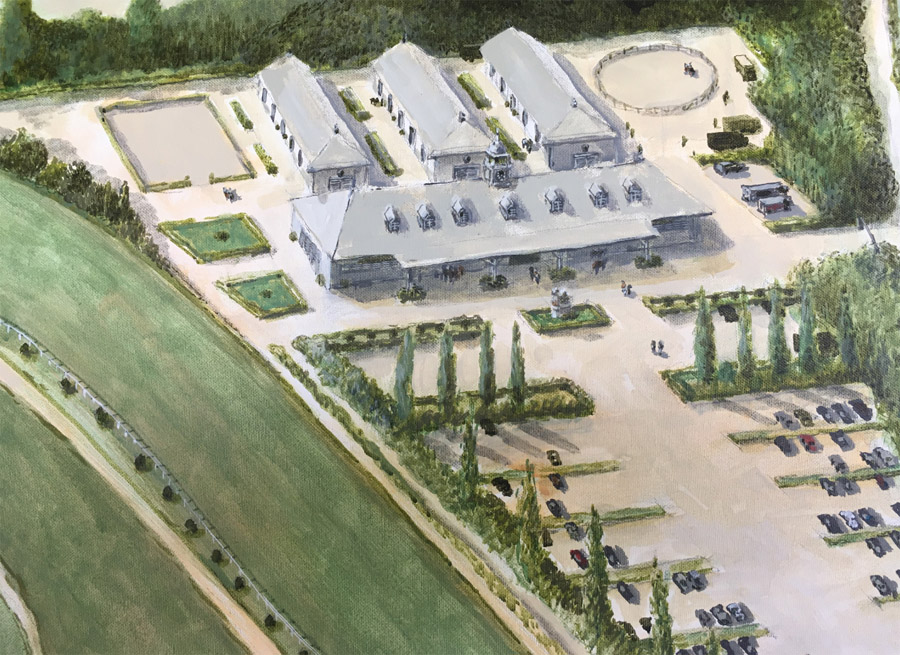Opportunity or Threat for Prague Velká Chuchle racecourse

There has been an unusually large number of reads of A Conversation with Martin Pecka, Manager of Prague Velká Chuchle racecourse, which I posted yesterday and which you can click on to immediately below this article http://www.dostihovy-svet.cz/en/node/8117. I concluded that the topic may be interesting for readers, as indeed it is for me. I thought I should therefore now add my comments on the Conversation, as promised, but sooner rather than later.
In the week before the Czech Derby, those of us who are on the list received a press release announcing plans for developing the Prague Velká Chuchle racecourse area, and also some sketches of an architect's ideas [see the picture with this article, and also the pricture with the Conversation with Martin Pecka]. We were invited to a press conference at the Konírna Wine Food Market, Italian restaurant https://www.winemarket.cz/provozovna-strakonicka-konirna. This is near Smíchovské Nádraží, between the railway station and the river. As the name suggests, it is a converted stables area, and it serves Italian food. I would happily recommend it for a meal, but not for a press conference, as the acoustics are poor. The acoustics in most converted or unconverted stables are not too good, I would guess.
After this kind invitation, I wanted to write an article. However, I was aware both from the press release and from the press conference, inasmuch as the acoustics allowed me to understand anything at all, that the plans for developing the racecourse were, how shall I put it, lacking in specificity. This was not displeasing, as the new owner should take time and gather data, options and opinions before embarking on major works. Although the racecourse area is run down, and would benefit from having several million euros spent on it, we are used to the way that it is. I was a bit concerned that the new owner might come along with dramatic new ideas that are not what is in the best interests of Czech racing.
Until I read Miloslav Vlček’s Conversation with Martin Pecka, which I put up on this website in an English translation yesterday, I was unsure what to make of the new owner’s “development plan”. The Conversation with Martin Pecka does give an indication of what the new owners of the racecourse have in mind, and it does form the basis for a discussion, though plenty of important questions remain unanswered.
Martin Pecka begins by stating that the racecourse is in worse condition than he had expected. This raises the question, What had he expected? There are plenty of racing professionals and racegoers who have spent large parts of their lives at the course, and are not surprised to hear that it is run down. The turf is still affected by the catastrophic flooding in 2002 and by being covered with water for some days in 2013. The lowest-lying parts of the racecourse area, near the starting point of 1 800-metre and 1 600-metre races, show evidence that they are water meadow, and have been flooded at roughly 20-year intervals, presumably since time immemorial. This affects not only the grass but also the subsoil.
As for the structures, the grandstand was newly built in the late 1980s. It is a big structure, and provides enough shelter, as well as seating with a good view of the races, for all racegoers. If I were the owner of the racecourse, admittedly, I would be frustrated that the grandstand was not constructed with a view to separating privileged boxes and areas with excellent facilities for corporate customers and rich individuals that could be rented at a high price, on the one hand, and less cosy areas with fewer comforts and an inferior view of the races for ordinary racegoers. However, I am not the owner of the racecourse, I am a racegoer. I like the fact that the main areas for viewing the races well and for congregating between the races are open for all. There are also enough boxes for closed groups, who are mainly corporate guests. But regular racegoers tend to congregate together as a single community. The new owners of the racecourse have not yet sought to divide us into those who pay a premium to keep dry, eat fine food and drink fine wines, and watch the horses in the parade ring and as they approach the finishing post, on the one hand, and those who shiver in their threadbare coats on cold, wet afternoons and queue for beer and sausages between races, on the other.
The grandstand building, constructed in the 1980s, has been standing for 30 years and was flooded to a depth of three metres in August 2002. It is said to be structurally sound despite the flooding, but of course it needs refurbishing. A group of racing fans had bought the racecourse at the end of 2001, to save it from the risk of being lost for horseracing, and eight months later they were faced by catastrophic flooding. There has never been money for all the maintenance and reconstruction that would have been desirable. Rather than complaining about the state of the racecourse, I am grateful that the racecourse that is the headquarters of Czech flat racing has survived for 112 years in its present location. And now, the Víteks, one of the Czech Republic’s richest families, have declared that they want to put a considerable amount of money, in your terms and mine, but a mere bagatelle to a billionaire family, into making Velká Chuchle racecourse into a fine equestrian centre. World class facilities for showjumping, in which the teenage Vítek daughters excel, are to be a special feature.
I interpret Martin Pecka’s gloomy comments about the state of the racecourse as, in part, tactical. If he says things were bad when he arrived, he will quite soon be able to point to great progress that has been made thanks to his management skills. That’s fair enough, from his point of view. Myself, however, I would like to acknowledge all the efforts that have been made at Velká Chuchle, not just to keep Czech horseracing’s head above water but to ensure that a bright future remains a possibility.
The next point from the Conversation with Martin Pecka [the surname is pronounced Petska, by the way] concerns the ownership of the racecourse area, and the unwillingness of the new majority owner to make major investments in an area that he does not fully own. There are two other owners. The minority shareholder in Turf Holding is the Jockey Club of the Czech Republic, and part of the land belongs to the Czech state. [For more details, see the Conversation with Martin Pecka]. Should the state and the Jockey Club sell their holdings so that developer and real-estate magnate Radovan Vítek can have a free hand to invest in and develop the racecourse area? If they do not, Vítek will not invest much in a location that he does not own. If they do, the Jockey Club will lose control over future use of the racecourse area. If we assume good will of the current owner, there still remains a risk that a future owner will be less benevolent toward the horseracing community. We must hope that the Czech state, too, as owner of some of the land, will resolutely ensure the continued designation of the Velká Chuchle area for horseracing purposes.
However, an even more important consideration is the role of the racecourse area in protecting the city of Prague from flooding. The sacrifice of Velká Chuchle racecourse and a large area of low-lying land along the left bank of the Vltava in 2002 narrowly saved the Old Town of Prague from catastrophic surface flooding of the Old Town - the worst of the flooding affacted the metro, the Lesser Town and the Prague 8 district, beyond the Old Town. Currently, the racecourse operators are required not to set up potential obstructions on the racecourse area that would adversely affect the use of the site as a flood overspill area. The new owners clearly want to build new structures on the site, and at the press conference, their architect stressed the importance of the impact of any changes on the environment. Nevertheless, good words and good intentions are not enough.
What Martin Pecka says about the racing calendar makes a lot of sense to me. It is strange to have the racecourse closed for 9 weeks between the Derby at the end of June and the St Leger at the beginning of September. During the midsummer season, Prague is full of tourists and Czechs are taking their holidays. This year, racegoers based in Prague have had to travel quite far and wide to go racing in July. The two-day meetings and Friday afternoon meetings that he suggests might work well. The organization of the racing calendar has not been perfect, and the traditional dates for racing at Velká Chuchle are not ideal. However, we have had several years of conflict between the racecourses and the Jockey Club, and it is far from easy to set up a racing calendar that attempts to provide series of races at all levels, for each age group, on the flat, over fences, hurdles and cross-country, when there are only limited numbers of races and horses to run in them, and when each racecourse has its own interests.
I accept what Martin Pecka says about the problems with organizing gambling at the Czech racecourses. Czech law on gambling has been more concerned with restricting fruit machines, casinos and offshore betting than with enabling betting on Czech horseracing. Czech racing should not dream that it is going to grow rich on revenue from betting, but there is a need for some recognition by the authorities that on-course betting on horseracing is a special category that deserves to be facilitated. Attempts to get recognition of the special situation of betting on horseracing have failed here so far, but things can only get better.
I hope that good times are going to come for Prague Velká Chuchle racecourse, with investments by Radovan Vítek and under the management of Martin Pecka. The racecourse has a good location in the suburbs of a fine city, and is worth a visit when you are in town on a race day. I hope the Jockey Club of the Czech Republic and the Czech state will find a way to cooperate with Radovan Vítek in developing the racecourse area for the future of Czech racing – and at the same time, no less importantly, to ensure that the area must be kept for horseracing and for flood protection!
